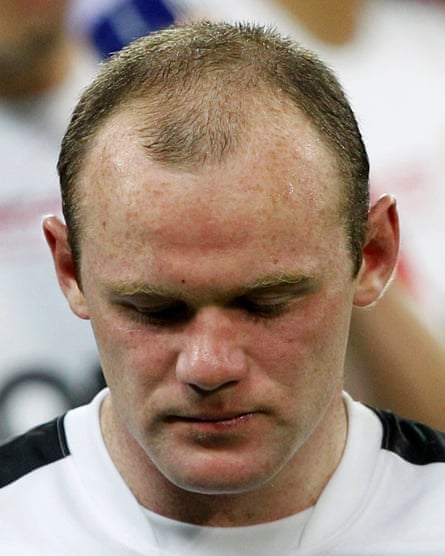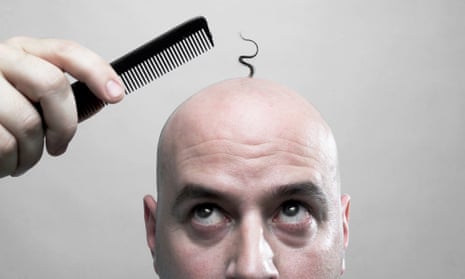Larry David was once asked what he was most proud of in life. “That’s easy,” the creator of Seinfeld and Curb Your Enthusiasm replied, “it would be the way I’ve adjusted to baldness.”
He reasoned that in a world where 75% of women say they wouldn’t date bald, the bald man who forswears hair plugs, periwigs, toupees, sombreros, simply has to try harder. “We have to dress a little better, make a little more money and have a little more charm just to compete. And we do. Have a conversation with a bald man sometime. Go ahead. Do yourself a favour. Tell me you don’t walk away impressed.”
David made this claim back in 2000. But fast-forward a few years and his enhanced compensation strategy begins to look a little quaint. Androgenetic alopecia, or male pattern baldness, afflicts about half of all men aged 50 and they can’t all reinvent the sitcom. And significant advances in the £3bn hair regrowth industry mean that they have other, seemingly easier, options. The man who is “ideally bald” (to use Vladimir Nabokov’s description of his comic hero, Pnin) may soon become a rare sight.
Hair transplant surgery – which works by painstakingly moving grafts of hair (typically two to four follicles at a time) from the back of the head to the temples and crown, the first parts to drop – is becoming mainstream. Wayne Rooney was frank about his 48-hour, £30,000 follicular unit extraction at Harley Street Hair Clinic in 2011, and is widely credited with changing attitudes towards the procedure. Actor James Nesbitt had one as he feared he’d lose out on roles as a bald man. “It was something I struggled with,” he said, “and that was probably the vanity in me.”
There are pharmaceutical solutions, too. Finasteride (often referred to by its brand name, Propecia) and Minoxidil (aka Regaine/Rogaine) are both available via online prescription in the UK. They stop hair falling out as opposed to making it grow back again, though some report more lustrous locks after three months or so. Donald Trump is the world’s most famous Propecia user. “Never go bald,” he once counselled. “The worst thing a man can do is go bald.” He’s not wrong. The anti-bald dating prejudice that David lamented extends to politics. Only five US presidents have ever been bald. As laughable as Trump’s follicular arrangements are, chances are that if nature had taken its course, a bald Trump wouldn’t have got to the White House. Careful what you wish for.

The Holy Grail remains a drug that will promote regrowth, but this might not be so far away. Earlier this year, Manchester University announced that an osteoporosis drug had been found to have “dramatic results” promoting hair growth when applied to tissue samples in pre-clinical trials. The resultant frenzy left the PhD student responsible, Dr Nathan Hawkshaw, a little dazed. “Every other week, something comes out about hair loss and it doesn’t generate as much media coverage as what I experienced,” he grumbles. He’s in this for the science – there aren’t many fields where you get to mess around with real human tissue – but such is the distress caused by hair loss and such is the potential customer base that interest is always high.
“It all started with a particular drug, Cyclosporine A, which is an immunosuppressant,” Hawkshaw explains. “It’s typically given to transplant patients to stop them rejecting new organs post-surgery and it’s been observed that it enhances hair growth. But the thing is, you don’t really want to give this to patients normally because you don’t want to suppress their immune system. So, I used that drug to treat human hair follicles in the lab to try and identify how it actually worked.”

It wasn’t quite the “accident” it was portrayed to be. He worked out that the drug targeted a protein called SFRP1, which affects follicle growth. He looked into the literature and discovered there was a pre-existing osteoporosis drug, WAY-316606, designed to target this protein with much more precision. So he applied that to leftover slabs of scalp donated by hair transplant clinics. “We usually do experiments for over a week. We put the hair follicles in a dish and this drug enhanced hair shaft elongation within two days. But it also kept the hairs healthier. When you look at them, they’re larger, thicker hair follicles. So, it’s quite promising.”
Hawkshaw is no longer working on the project, but the Italian pharmaceutical company, Giuliani, hopes to take his findings through to clinical trials. An American start-up, RiverTown Therapeutics, is exploring a similar avenue with a drug known as RT1640. And it’s fair to say that whoever gets there first will make a lot of money.
“There are so many different groups going down different avenues to tackle this problem,” says Hawkshaw. “Some use stem cells, some use pharmacological drugs, as we did. There’s a lot of promise in these pre-clinical studies. But whether that extends to real life, we’re not sure yet.” While it is essentially a cosmetic issue, that doesn’t mean it’s trivial. “It causes severe psychological distress,” he says bluntly. “It makes a big difference to a person’s perspective of life.” While he’s pretty lustrous at 28, he does worry about losing his own hair. “It’s a human universal.”

Male patten baldness affects about 20% of men by the time they’re 20 and rises roughly in line with age: about 30% of men will experience significant hair loss by 30, 40% of men by 40, half of men aged 50, and so on. If you’ve retained your hair by middle-age, you’re one of the lucky ones. I’m elated to say that I’m well thatched at 37, but the grey specks in my beard bother me enough to know that if I did lose my hair, I’d be dismayed. For some reason, there is something inherently conical, sorry comical, about baldness; some people can deal with that and indeed, emerge stronger and surer of themselves. It’s fair to say Jason Statham wouldn’t have been a match for a prehistoric shark with his 1995 hair. But for others it’s just not so easy.
One friend who went bald in his early 20s said that even once he’d readjusted to his new look, the thing that saddened him was that this look would define him pretty much for ever. Another, now in his 40s, found it dispiriting when his hair started falling out in his 20s – “the first sign that my youth was fading…” He decided against Minoxidil and Finasteride – “If I recall correctly, one of the side effects was impotence or diminished libido, which didn’t seem a good trade-off” – and found the idea of surgery “laughable”, so opted to shave it all off, finding some cheer in the new-found solidarity among his fellow balding friends. Still, he says, anti-bald prejudices are real.
“There’s the ‘I don’t date bald men’ line – hard to argue with, but still an injury to one’s pride.” Then there are a surprising number of people who call out “baldie!” in the street, or equate a shaved head with homosexuality and/or neo-Nazism. “I’ve had baldist/homophobic abuse in the street a couple of times and I’ve even been asked on the Tube: ‘Are you BNP, mate?’ When I expressed bewilderment at this, I was told: ‘It’s the hair, innit.’”
Baldness is not caused by excess testosterone as is commonly thought; nor is it inherited from your maternal grandfather. It’s caused by sensitivity to testosterone: an enzyme converts testosterone into a substance called dihydrotestosterone – which then causes the follicle to shrink and fall out. Male pattern baldness is inherited, but from both or either side of your genetic line. Why men go bald, we’re not sure – though there is a hypothesis that baldness was once a genetic advantage. People tend to associate baldness with virility and wisdom. The bald hunter-gatherer would have been a natural choice for a chieftain back when life expectancies were shorter and bald heads rarer. In our age of appearances not so much. Of 17 male members of Cabinet, two are bald (Chris Grayling and Sajid Javid). Studies correlate baldness with depression; the term “psycho-trichological” is used to describe the feelings of disfigurement, social avoidance and anxiety disorders that often arrive with premature baldness.
“I was 21 when I noticed my hair getting thinner,” says David Anderson, 45, who has had seven hair transplants. He is now senior patient adviser at the Maitland Clinic in Liverpool, one of the country’s leading hair transplant clinics, where he raises awareness of the vulnerability of sufferers. “It was devastating. It completely consumed my existence. Now, I really regret that. But time and again, I’m meeting patients going through the same anxieties. It’s an epidemic. A lot of people don’t understand how it can make you feel.”
He now enjoys full scalp coverage, which he credits to modern transplant techniques combined with Propecia – but when he embarked on what he refers to as his “hair-loss journey”, there weren’t so many options. One trichologist advised him to dunk his head in freezing cold water six times per day; another zapped his scalp with infra-red light; finally, he opted for surgery. “The techniques were far less refined – 450 grafts,” he says. “Now, we can move 4,500 grafts in a single session. It left me with scars at the back of my head. And I committed to more and more procedures. Each time, they were taking another strip of tissue from the back of my head, leaving another scar.” He was eventually “fixed” at a surgery in Vancouver, but in his present role he talks people out of surgery as much as talking them into it. “I wish I could turn back the clock so I never had surgery,” he says.
While techniques have advanced, the bald are no better served, says Spencer Kobren, who runs Bald Truth, a website and podcast in the lustrous world of the alt-bald media. He has learned to be highly suspicious of anything announcing itself as a cure; indeed, he resolutely fails to get excited about RT1640 or the Manchester findings. “I have been doing this for 20 years,” he tells me from his home in Beverly Hills. “When I wrote my book in 1998, they had just found the hair loss gene. There was talk of hair clones. There was a cell-based solution coming out of Japan. It was like: ‘This is it! We’re going to cure this in five years!’” He’ll believe it when he sees it.
Like Anderson, he started to lose hair at 21 and tried similarly baroque remedies. “At the time, there was nothing except the snake oil you found at the back of muscle magazines.” He rubbed cayenne pepper into his scalp; he hung upside down; he visited a company that promised a miracle cure that turned out to involve a wig glued on to his head. He looked up a few British trichologists and surmised that trichology was a “study of bullshit” then visited an eminent hair surgeon whose eagerness to perform surgery immediately put him off the idea. It was the discovery of Propecia that ultimately “saved” him. “The drug stopped my hair loss. I had no adverse side effects. I regrew my hair on the crown.”
But as bad as it was back then, it’s worse now, he says. “On the internet, everyone has a cure for hair loss. There are YouTubers with huge followings who make high incomes from Google ads promoting laser caps and all sorts of nonsense. If you have any type of a clinical or a critical mind, you think, how could anyone fall for this?”
The combination of silent suffering, public shame and poorly understood science makes hair loss sufferers easy prey – type “hair loss” into Google and you’ll see what I mean. Kobren tells me that he had to remove the personal messaging function on the Bald Truth message board, as users were being bombarded by scams. Meanwhile, the higher visibility of celebrity transplants means that baldness is at risk of being seen as a sign of poor self-care. Many treat surgery lightly – and enter into punitive financing deals. One of Kobren’s recent guests was The Only Way is Essex star Maria Fowler, who complained that surgery at the controversial KSL Hair in Glasgow left her with an unnatural hairline. “She ended up having a hair transplant because her fiancé was having one. She had always thought her hairline was too high. She went in like she was having her nails painted – and it destroyed her life.”

I wonder whether hair loss would get as much attention if it were primarily suffered by women. But Kobren corrects me. “Actually, 40% of hair loss sufferers are women,” he says. “Except women are able to wear wigs and hair extensions and they can camouflage it in a way that men aren’t really allowed to.” He describes female pattern hair loss as a “silent epidemic of biblical proportions” that he puts down to the use of cosmetics and birth control (some women experience hair loss as a side effect to contraceptive pills).
But the male propensity to internalise their feelings often leaves them particularly vulnerable. “I know guys who have changed their career paths because of their hair loss,” says Kobren. “I know a lawyer who began delivering potato chips so he could wear a cap to work. I know an NYPD officer who was so devastated by a bad transplant, he had to retire and he ended up on disability benefit.”
For him, the first line of attack is acceptance. “Cut your hair as short as you can. If you can own it, you can beat baldness. But with the rise in hair transplants, most people aren’t in that mindset.” While anyone of any conscience will say that Larry David’s approach is preferable, in a world of quick fixes and fake news, it’s increasingly the Donald Trump approach that’s on the ascendancy.
